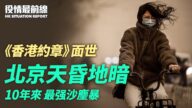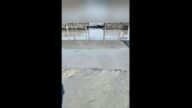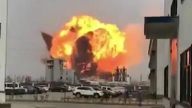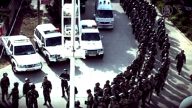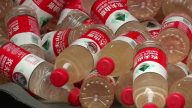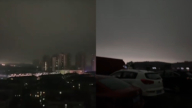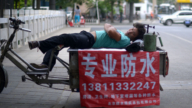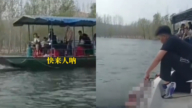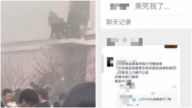【新唐人2012年6月6日讯】近年来,大陆市区一些从事生产、贮存有毒物质的企业,纷纷迁离,退出繁华地段。遗留的大量有毒土地却成为了房地产开发商的“宝地”,最终成为民众的居住地。专家指出,这些“毒地住宅”严重影响居民的健康。但中共当局对外严密封锁消息,环保部门也不公布调查情况。
中共实行的城市“退二进三”计划,使产生于50多年前“大跃进”时期的众多高污染工业企业关闭、搬迁。由于地理位置优越便利,几乎所有的地块都进行了开发。但是,有不少“毒地”未经治理,就被正常使用。
北京广渠门“15号地块”,原来就是一家化工厂,入市拍卖成为2009年的北京“地王”,经修复后建起豪宅。
正在开工的北京管庄乡“康泉新城”二期,是为各部委公务员建设的保障性住房,地址就是七八年前迁走的铁道部所属“防腐枕木厂”,住宅总建筑面积达26.19万平方米。 但是,“防腐枕木厂”在这里生产30多年,期间大量使用防腐蚀、抗老化等化学品,产生了多种有机污染。
“中国环境科学院”所做的报告显示,“康泉新城”二期场地土壤样本中有19种污染物,其中,“多环芳烃”的最大超标倍数超过一千倍。
“国立台湾师范大学”化学系所教授吴家诚表示,“多环芳烃”是致癌物质,是持续的有机污染物。这些化学污染被很多国家称为“环境荷尔蒙”,因为它能产生不正常的荷尔蒙,影响人的生殖系统、发育系统,还会通过妈妈传给小孩。
“国立台湾师范大学”化学系所教授吴家诚:“量多的话,如果跑到人类的食物链里面来,或跑到人类的饮水里面来,或跑到空气里面来的时候,他就会产生内分泌的不正常,或者是产生癌症,这个东西毒性是蛮大的。要处理的时候,必须把当地的土壤全部挖掉,挖掉以后,再去后续处理。”
大陆业内专家透露,各类不同性质的全国污染场地应以万计,仅是农药厂污染的场地就占据相当高的比例,但处理和正在处理的屈指可数。
而自2004年以来,因开发毒地引发的急性中毒事件也陆续被曝光。
2004年4月28号,位于北京市南三环的宋家庄地铁建设工地,三名在地下作业的工人因中毒被送往医院,出事地点是一家农药厂的原址。
2007年中国新年前,武汉黄金地块“赫山地块”施工现场,随着深层土壤被挖出,数名工人也因中毒被送往医院紧急救治。这里原属“武汉市农药厂”。
环保作家郑义指出,化学物质的污染对土地是致命的,因为化学物质的毒性在相当长的时间内,甚至上百年都不可能被吸收或者转化,这使得土地成了废地,等于毁掉了这个民族的生存基础。
环保作家郑义:“那么,这种污染它已经把我们生存的底座,把我们的基础全毁掉了。所以这是一个令我们中国人疼痛的一个事实。这是现代科学技术,还没有找到任何可以修复的可能。总之,这个事情是非常绝望的,这是共产党坚持它的这样一种政治体制、坚持不走民主开放之路、不走法制的道路,所以官商勾结。这种大规模的污染永远也是治不了的。”
但中共当局对外严密封锁消息,环保部也不公布调查情况。
据《东南快报》报导,一位参与多起土壤修复专案的专家透露,广州某处楼盘曾是一家重点化肥厂,重金属与石油类污染物都超标,广州亚运村曾选定这里,但在发现场地污染后不得不改变位置,而这个楼盘的居民始终不知道真实情况。
采访/梁欣 编辑/宋风 后制/君卓
Living On Toxic Land
In recent years, many companies engaged in the production
and storage of toxic substances moved out of the downtown.
Large amounts of toxic land have become the “treasure" of
real estate developers, and eventually became residential.
Experts pointed out the “poisonous residential area" seriously
affects the health of residents.
The Communist authorities blocked the news, and the
environmental protection department did not announce the results of the investigation.
The Chinese Communist Party (CCP) implemented the plan of
“Two Out, Three In",
making many high-polluting industrial enterprises formed in
the 1950s during Great Leap Forward close down and move out.
Since the location was convenient, nearly all the land was
developed.
But a lot of “toxic land" was used normally without appropriate
treatment.
#15 block in Guangqumen, Beijing was originally a chemical
plant to start with.
In the stock market auction in 2009, it got the highest price
and was rebuilt into a mansion.
Kangquan Metro II, which just started in Guanzhuang Village,
Beijing, is affordable housing built for clerks in ministries.
The address is the anti-corrosion sleeper factory of the
Ministry of Railways, which moved out seven years ago.
The gross floor area is 261,900 square meters. Anti-corrosion
sleepers were in production there for over 30 years,
during which they extensively used anti-corrosion,
anti-aging and other chemicals, leaving lots of organic pollution.
According to China Environmental Sciences Institute report,
soil samples on the site of Kangquan Metro II contain 19 pollutants.
Polycyclic aromatic hydrocarbons exceeds the
standards by 1,000 times.
Professor Wu Jiacheng in Department of Chemistry,
National Taiwan Normal University said,
polycyclic aromatic hydro-carbons are carcinogenic and
persistent organic pollutants.
The chemical pollution is known as environmental hormones
in many countries,
because it can produce abnormal hormones,
affecting people’s reproductive system, developmental systems.
Pollution is passed on to children through the mother’s womb.
Professor Wu Jiacheng said, “If the quantity is large, and it
goes into the human food chain, or drinking water, or the air,
it could cause abnormal endocrine functions, or cancer.
It’s quite toxic.
To treat the soil, you must dig out all local soil,
and then send it for follow-up treatments."
Experts in China said various contaminated sites
should be in the tens of thousands.
Pesticide plant contaminated sites alone account for a
very high percentage. Few are treated or undergoing treatment.
Since 2004, acute poisoning cases created by toxic land
development have been exposed one after another.
On April 28th, 2004, on the subway construction site of
Songjiazhuang, the South Third Ring in Beijing,
three workers underground were rushed to hospital due to
poisoning. The poisoning site was originally a pesticide plant.
Before Chinese New Year of 2007, on a construction site in
Haoshan Block, a golden block in Wuhan,
many workers were rushed to hospital for emergency
treatment due to poisoning after digging out deep soil.
The site was originally the Wuhan pesticide plant.
Environmental writer Zheng Yi pointed out chemical
Pollution of the land is fatal,
because the toxicity of chemical substances last for a long time;
they cannot be absorbed or converted for over a century.
It makes the land wasteland. It is equal to destroying the
survival basis of this nation.
Environmental writers Zheng Yi: “This kind of pollution has
destroyed the base of our survival and our foundation.
It is a painful truth of all Chinese people. Modern science and
technology have yet to find a way to repair the damage.
In short, it is very desperate because the CCP insisted on such
a political system, but not a democratic path, or legal path.
So officials and businessmen colluded together.
The large-scale pollution can not be cured at all."
The Communist authorities blocked the news release.
The Ministry of Environmental Protection also won’t release the results of investigation.
Southeast Express reported that an expert involved in many
soil remediation projects revealed an estate in Guangzhou was a key fertilizer plant.
The heavy metals and petroleum pollutants
exceed safety standards.
Guangzhou Asian Games Village once selected that area,
but had to change to another location after the discovery of the contaminated sites.
Residents in the housing area still do not know the truth.



